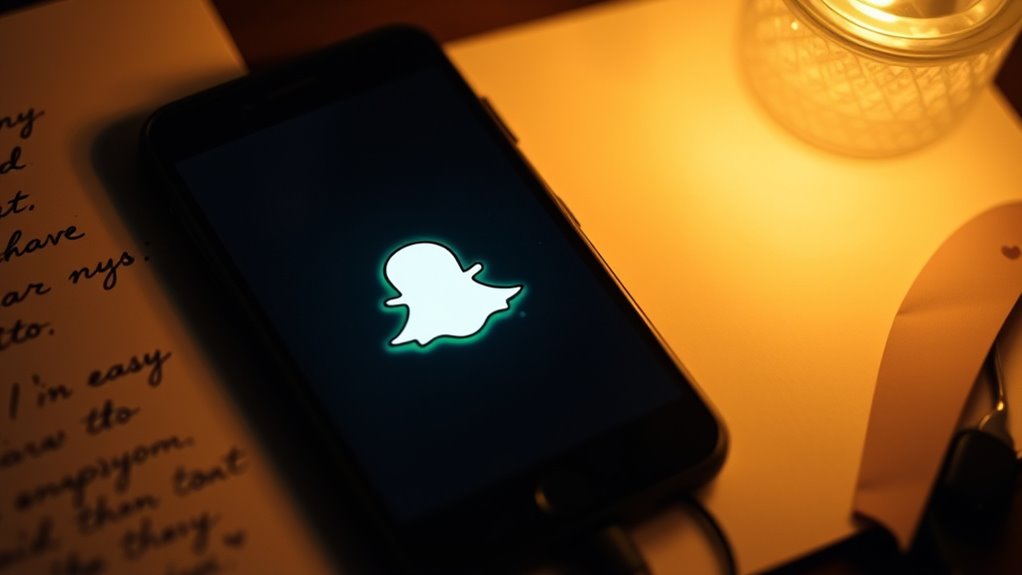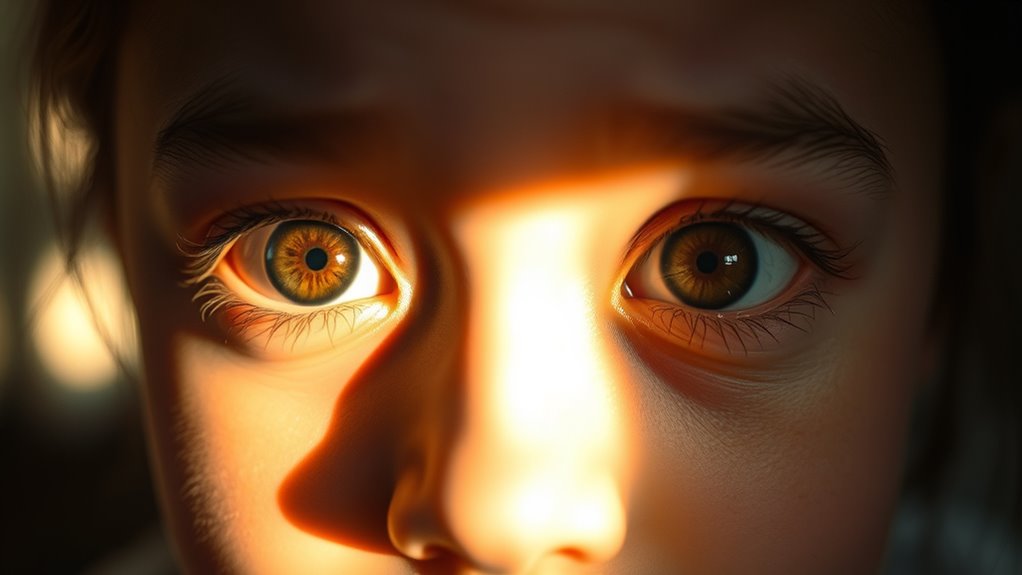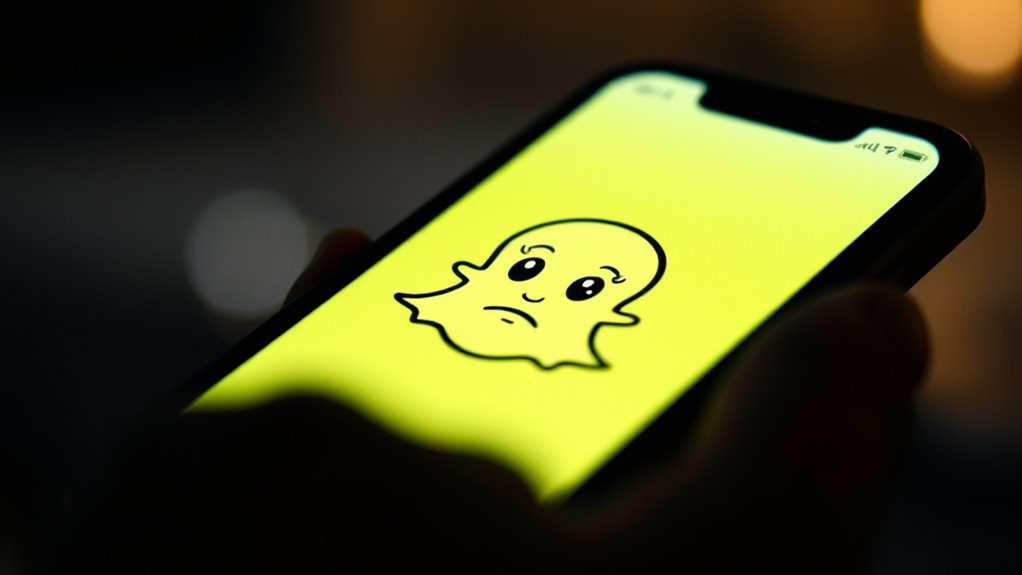On Snapchat, 🥺 usually expresses vulnerability, affection, or genuine emotion. You might use it to show you’re feeling emotional, asking for understanding, or being sweet and sincere. Its meaning can change depending on context, making it versatile for tenderness, pleading, or even playful teasing. Recognizing how others use 🥺 can help you interpret their feelings better. Keep exploring to discover how this emoji’s nuanced use can help deepen your digital interactions.
Key Takeaways
- 🥺 expresses vulnerability, sincerity, or emotional pleading, often used to convey sadness, gratitude, or tenderness on Snapchat.
- The emoji can signal genuine feelings or playful teasing, depending on context and tone.
- It enhances digital communication by adding emotional nuance, making messages feel more heartfelt or sincere.
- Cultural and platform differences may influence its interpretation, from sympathy to affection or sarcasm.
- Recognizing the context helps understand whether 🥺 is sincere, shy, or teasing in Snapchat conversations.
The Emotional Significance of 🥺 on Snapchat

Have you ever wondered what the 🥺 emoji really conveys on Snapchat? Its emotional significance has evolved over time, reflecting changes in emoji evolution. Originally, this emoji represented sadness or pleading, but now it often symbolizes vulnerability or heartfelt sincerity. Cultural differences also influence how people interpret 🥺; in some cultures, it’s used to show humility or gratitude, while elsewhere, it might express sympathy or emotional appeal. Recognizing these nuances helps you understand why someone might send 🥺—it’s not always about sadness. Instead, it often conveys a complex mix of feelings, from longing to appreciation. Understanding emotional expression helps in better interpreting the intent behind the message and respond more thoughtfully.
When to Use 🥺 in Your Snaps and Chats

Knowing when to use 🥺 in your snaps and chats can help you communicate more effectively and authentically. The emoji evolution shows how 🥺 has shifted from simple expressions to nuanced emotions, making it versatile for various contexts. Consider cultural differences—what might be playful or cute in one culture could seem overly dramatic in another. Use 🥺 when you want to convey vulnerability, pleading, or genuine emotion without words. It’s also helpful in moments where you want to show that you’re seeking sympathy or understanding. Understanding emoji meanings can guide you in choosing the right moments to use 🥺 appropriately. However, avoid overusing it, as excessive use can dilute its meaning or seem insincere. Being mindful of the context and your audience guarantees you’re using 🥺 appropriately, making your messages feel relatable and genuine.
Interpreting Different Contexts of

When you see 🥺 in different messages, it’s important to contemplate the context to understand what it really means. You must interpret the emoji alongside other social cues and the tone of the conversation. Remember, the same 🥺 can express genuine emotion or playful teasing depending on the situation. Recognizing emotional expressions with emojis like 🥺 can enhance your understanding of digital communication cues.
Expressing Emotions Clearly
The 🥺 emoji on Snapchat can convey a variety of emotions depending on the context, making it important to interpret its meaning carefully. In online communication, emoji trends influence how people express feelings, and 🥺 is no exception. Sometimes, it shows vulnerability or sadness, like when you’re upset but want to seem gentle. Other times, it’s used to plead or ask for something kindly, such as a favor or reassurance. You might also see it as a way to express gratitude or appreciation subtly. Recognizing these different uses helps you understand the sender’s true emotion behind the emoji. Since emoji trends evolve quickly, staying aware of current social cues allows you to interpret 🥺 accurately and respond appropriately in your conversations. Being mindful of emoji symbolism can further enhance your understanding of subtle emotional cues in digital chats.
Understanding Social Cues
Understanding social cues involves recognizing how the 🥺 emoji can change meaning based on the situation. As emoji evolution continues, the same symbol can convey different emotions depending on context and cultural differences. For example, in some cultures, 🥺 might express genuine sadness or pleading, while in others, it’s used playfully or sarcastically. You need to pay attention to the tone of the conversation and the relationship with the sender. The way people interpret emojis has evolved alongside digital communication, making it essential to contemplate social cues carefully. Recognizing these subtle shifts helps you respond appropriately and avoid misunderstandings, especially as emoji meanings adapt across diverse social and cultural settings. Additionally, understanding the effectiveness of emoji communication can help you better interpret the sender’s true intent.
Context Matters Most
Context shapes the meaning of the 🥺 emoji more than anything else because the same symbol can convey vastly different emotions depending on the situation. Its interpretation relies heavily on the surrounding conversation and cultural differences. For example, in one context, 🥺 might express genuine sadness, while in another, it signals pleading or cuteness. Understanding emoji evolution helps you recognize these shifts in meaning over time. Be aware that cultural differences influence how this emoji is perceived—what’s innocent in one culture might seem emotional in another. Here’s a quick comparison:
| Situation | Emoji Interpretation |
|---|---|
| Apologizing or pleading | Genuine vulnerability |
| Expressing gratitude | Sweet or endearing |
| Showing sadness or disappointment | Sincere emotion |
Always consider the context to decode 🥺 accurately. Recognizing how emoji meanings vary across different cultural contexts can improve your communication and help prevent misunderstandings.
The Meaning Behind 🥺 in Romantic Interactions

Have you ever noticed someone sending 🥺 during a romantic chat and wondered what they really mean? In the emoji evolution, 🥺 has shifted from a simple expression of sadness to a versatile symbol in digital communication, especially in romance. When used in romantic interactions, 🥺 often conveys vulnerability, affection, or a plea for attention. It’s a way to show that you’re emotionally invested or seeking reassurance without words. Sometimes, it adds a layer of sincerity or sweetness, making your message feel more heartfelt. This emoji allows you to express tenderness subtly, encouraging a partner to respond with care. Its meaning depends on context, but generally, it’s a gentle way to deepen romantic connection through visual language. Additionally, understanding the emotional expression behind 🥺 can help you interpret its true intent more accurately.
How Friends and Followers Use 🥺 Differently

While 🥺 can carry romantic undertones, friends and followers often use it to convey different emotions or intentions. Over time, emoji evolution has expanded its meanings beyond affection, making it a versatile tool in digital communication. Cultural differences also influence how 🥺 is interpreted; in some regions, it signals vulnerability or pleading, while elsewhere, it shows sympathy or mild embarrassment. As a result, your friends might use 🥺 playfully or sincerely, depending on their background or the context. Followers may use it to express concern or to soften a request. Recognizing these subtle distinctions helps you understand the varying ways people incorporate 🥺 into their messages, reflecting their unique cultural lenses and evolving emoji usage. Additionally, understanding the context within the cultural significance of emoji use can enhance your interpretation of these subtle cues.
Variations of 🥺 and Similar Emojis

You’ll notice that variations of 🥺 and similar emojis express different shades of emotion. Emojis with different faces and colors can show sadness, pleading, or even playfulness. Recognizing these subtle differences helps you understand the tone behind each message more accurately. Additionally, understanding the emotional nuances of these emojis can enhance your communication by conveying your feelings more precisely.
Variations of 🥺 and Similar Emojis
Just like 🥺, many other emojis share similar meanings or evoke comparable emotions, but they also come in various forms and styles that can subtly change their tone. Over time, emoji evolution and cultural variations shape how these symbols are perceived. For example, a pleading face emoji might be used to express vulnerability in one culture or sarcasm in another. Different platforms or devices may also display slight style changes, affecting tone. Here’s a quick look at some variations: emoji interpretation can influence how messages are received and understood across different contexts.
Expressive Faces and Shades
Expressive faces and shades add depth to the way emojis convey emotions, allowing for subtle differences in tone and intent. The emoji evolution shows how these variations help you express complex feelings beyond basic happiness or sadness. Cultural influences also shape how you interpret and use different shades and expressions, making emojis more personalized and meaningful. For example, a slightly different facial expression or color can indicate sarcasm, embarrassment, or affection. These nuances allow you to communicate more precisely, adding layers to your messages. By understanding the subtle differences in expressive faces and shades, you can better navigate emotional conversations on Snapchat and other platforms. This evolution reflects how emojis continue to adapt, offering richer ways to share your feelings visually. Recognizing emotional nuance in emojis enables more accurate and heartfelt communication in digital interactions.
Tips for Responding to 🥺 Messages

When responding to 🥺 messages on Snapchat, it’s important to acknowledge the emotion behind the emoji to keep the conversation meaningful. Recognize that the emoji evolution reflects how digital communication has become more expressive, allowing you to convey feelings quickly. To respond effectively, consider matching the tone—if the 🥺 seems sad or pleading, offer reassurance or support. If it feels playful or shy, a lighthearted reply works best. Remember, emojis help clarify intent, so your response should validate the sender’s feelings without dismissing them. Being attentive to the context and emotional nuance behind 🥺 messages fosters genuine connection, even through a simple emoji. Incorporating emotional awareness into your responses can enhance understanding and strengthen your interactions. Adapt your reply based on the mood to keep the conversation authentic and engaging.
Frequently Asked Questions
Can 🥺 Be Used to Express Sarcasm or Mock Sadness?
You can use 🥺 to express both sarcasm versus sincerity, but it’s often tricky. In mock sadness usage, you might exaggerate your feelings, making it clear you’re joking. However, context and tone are key—if someone knows you well, they’ll likely understand if you’re being sarcastic or genuinely upset. So, while 🥺 can convey mock sadness, it’s best to clarify your intent to avoid misunderstandings.
How Does 🥺 Differ From Similar Emojis Like 😢 or 😭?
You’ll notice 🥺 conveys a softer, more pleading emotional nuance compared to 😢 or 😭. Its facial expression shows wide eyes and a gentle, almost hopeful look, making it perfect for expressing vulnerability or begging. Unlike 😢, which signals sadness, or 😭, which shows intense crying, 🥺 captures a tender, endearing feeling that’s more about seeking sympathy or connection in a subtle way.
Is 🥺 More Common Among Certain Age Groups or Communities?
You’ll find 🥺 more common among younger users, especially teens and young adults, as part of age-specific emoji usage. It’s also popular in community-based expressions to convey vulnerability, pleading, or cuteness. Different groups might use it to emphasize emotional sincerity or to connect more personally. Overall, 🥺’s usage varies by age and community, making it a versatile emoji for expressing gentle feelings across social circles.
Can 🥺 Be Used in Professional or Formal Conversations?
You probably shouldn’t use 🥺 in professional or formal conversations since it generally isn’t considered appropriate. It’s best to stick with professional etiquette and avoid emoji appropriateness issues that could come across as unprofessional or overly casual. In formal settings, using words clearly expresses your message, keeping your communication polished and respectful. Save emojis like 🥺 for informal chats with friends or close colleagues who understand the tone.
Are There Cultural Differences in How 🥺 Is Interpreted Globally?
Think of 🥺 like a chameleon, changing its color based on where you are. Cultural interpretations and regional usage influence how people see this emoji; in some places, it’s sincere and heartfelt, while elsewhere, it’s playful or even manipulative. You’ll find that its meaning varies globally, so you should consider cultural differences when using 🥺. Otherwise, you might unintentionally send the wrong message, like a traveler misreading a local sign.
Conclusion
Understanding 🥺 on Snapchat reveals both vulnerability and affection, like a gentle whisper in a noisy room. It’s a soft, emotional cue that can soften a tough day or deepen a romantic connection. While it might seem small, its meaning shifts with context—sometimes playful, sometimes heartfelt. Recognize its subtle power, and you’ll navigate your chats with more empathy and clarity, turning simple emojis into meaningful moments amid the digital chaos.









